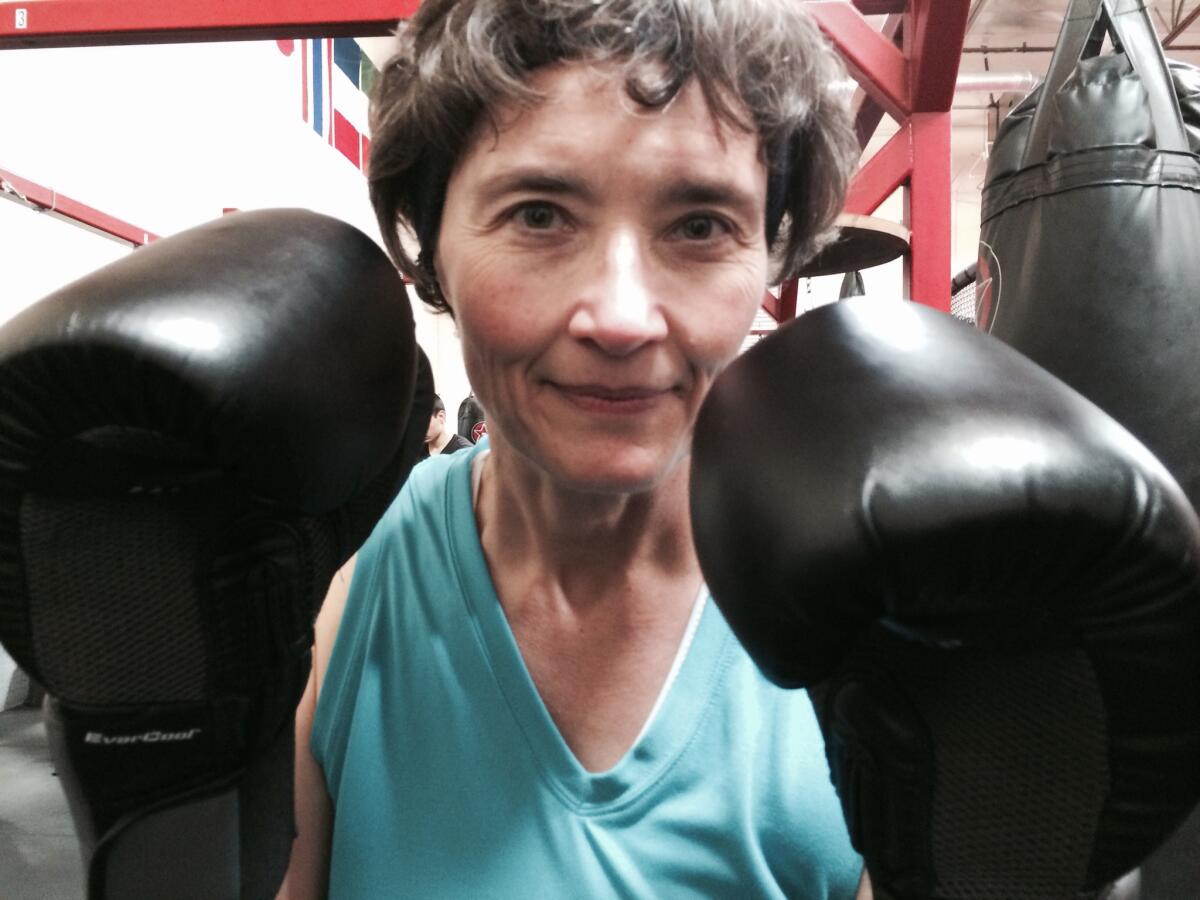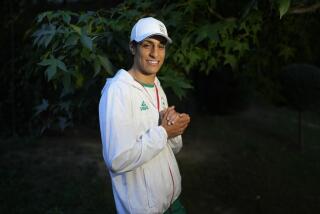Column: This minister can preach virtues of boxing — and practice them

- Share via
With her snowman’s smile and twinkling eyes, Ann Schranz may not be everybody’s mental montage of a boxer. For one thing, she’s 58, a little on the north end of the sweet science. And her guns? Not loaded. Her long arms are toned, not ripped. They’ll never make anyone forget Mike Tyson (much as we’d like to).
But her opponents never had a prayer.
Because Schranz is a minister. And even if you’re fed up with athletes who credit the Almighty for their success — as if he sits around like some sort of bookie handicapping outcomes — you have to wonder if this punching pastor at least packs a spiritual edge.
Like author Joyce Carol Oates, she wonders if life isn’t a metaphor for boxing, rather than the other way around. “Life is like boxing,” Schranz says. “But boxing is like nothing else.”
Jab. Duck. Hook. Jab. Duck. Uppercut.
Sure, seems a strange hobby for a minister. But exercise is about embodiment. It has helped her “recalibrate,” Schranz says, and to drop 50 pounds since she took up the sport three years ago.
And then there is that whole spiritual aspect. You learn to take a punch. Soreness is not pain. The literal informs the metaphorical.
In a smart and self-effacing sermon about her hobby, the reverend cited a passage by David O. Russell:
“That’s the most beautiful thing ... about boxing. You can take a punch,” the director of “The Fighter” once noted. “The biggest thing about taking a punch is your ego reacts and there’s no better spiritual lesson than trying to not pay attention to your ego’s reaction.”
Says Schranz: “It reminds me of the difference between feeling neurotic pain and real pain. With neurosis, there are a lot of things that feel like assaults on the self. With greater degrees of mental and emotional health, fewer things feel like assaults on the self.”
A steady soul with an easy charm, the Wisconsin native laughs when she recalls classmates’ reactions when they discover she’s a minister, something she doesn’t necessarily go around announcing.
“You’re what?” asks David Dunscomb, 26, during a break.
“How do I compete with that?” he says with a smile.
On this day, Schranz is working with instructor Clement Lacroix on rolling the hips when throwing a punch. Hooks. Jabs.
Uppercuts. Jab-jab-jab. A million jabs. A good fighter’s nervous tic.
Recently, Lacroix urged her to “squish the bug,” with her rear foot. Really helped her hook. She’s also learning that power starts in the basement — feet, legs, hips, torso, then hands.
Amid the rap music in a Rancho Cucamonga gym forested with tattoos, she looks a bit out of place during workouts.
But once she gets moving....
OK, she still looks out of place. Her gloves are seemingly outsized, as if she’s holding a couple of couch cushions. But that snowman’s smile is never far away.
“Today we’re going to work on defense first, then the attack,” Lacroix tells the class of six boxers.
Horrible eyesight prevents her from taking part in sanctioned amateur bouts, Schranz says. But she is always seeking potential sparring mates, who are rarer and rarer these days as mixed martial arts dominates many gyms.
Till then, these four-day-a-week sessions at Millennia training center keep her in fighting shape.
“It’s easy to work hard,” she says, “because everybody here is working hard.”
As is her nature, she advocates for the sport, and keeps tabs on it through the Women Boxing Archive Network, a website for news and results. She uses Jill Morley’s “Fight Like a Girl” documentary as a motivating tool, and urges other to as well.
Of course, boxing may not be her main calling. The needs of the 125 members at the Monte Vista Unitarian Universalist Congregation in Montclair clearly trump that.
But more and more, they are not distinct things. One rolls into the other, making her stronger in each. “Be like a Slinky,” one trainer told her a while back. “Flash your weight from one leg to the other.” And that’s just what she does, literally and metaphorically.
“Boxing is spiritual the same way that exercise is spiritual,” she told her congregation one Sunday. “Through exercise, I learned that soreness is not pain.... Reframing ‘pain’ has been part of my spiritual growth.
“Pay attention to the process,” she urged them, “let go of the attachment to outcome.”
And, more than anything, learn to take a punch.
Twitter: @erskinetimes
More to Read
Go beyond the scoreboard
Get the latest on L.A.'s teams in the daily Sports Report newsletter.
You may occasionally receive promotional content from the Los Angeles Times.











